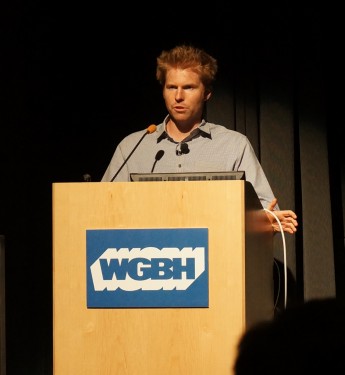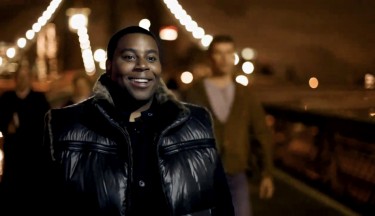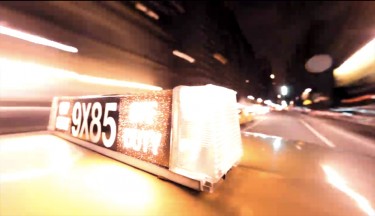 Back to selection
Back to selection
Alex Buono: Shooting for Saturday Night Live
Alex Buono is perhaps best known for his work with the Saturday Night Live Film Unit. He shot the current opening for SNL, as well as many of the fake commercials seen on the show, but his passion is documentary and making independent films. “I’m always trying to get the next one off the ground,” says Buono, “and SNL, as much as I like it, it’s a lot of fun and I really like who I’m working with, [but] it’s this great day job I do while I’m trying to get a movie [going].”
Most recently, Alex worked on the pilot for NBC of a series called Chicago Fire, shooting second unit with DSLRs and a Canon C300. “I’m able to do things that [others] don’t understand how you can accomplish without 60 people?”
Alex recently spoke about his work on SNL, and shooting with DSLRs and Canon’s C300, at an event jointly sponsored by Canon, WGBH’s Frontline and Rule Boston Camera.

Alex’s journey to SNL was unorthodox. He went to film school at USC in L.A., but never even thought of working on SNL. It was only after shooting a never-finished, low-budget independent film in North Carolina that one of the producers who also worked for SNL said to him afterwards, “Hey that was kind of a horrible experience, but you’re a cool guy, do you want to come and shoot something for us?” That was in 1999, and now he’s starting his 15th season on the show.
When Alex joined the SNL Film Unit, it was still shooting on 35mm film. SNL’s schedule is notoriously tight; the writers have Monday through Wednesday to write, then on Wednesday there’s a table reading where they pick the sketches for Saturday’s show. The filmed sketches and pre-taped or fake commercials are chosen, and they have Thursday to prep and Friday to shoot. Sometimes the schedule is even further compressed; for last season’s Real Housewives of Disney sketch, which required the entire cast, they couldn’t get them until rehearsals for the day had finished. The piece was shot from midnight on Friday through 4am, going to air less than 24 hours after shooting started. “When we were shooting on film stock, that was really difficult,” said Alex. “As much as we love shooting on film, the bottom line is our turnaround times are so short, they are ridiculous.”
SNL began moving away from film in the 2000’s, first with mini-DV, and then HDV. The tape-based workflow was a lot easier to work with, but it didn’t look very good. “We really missed the days when we shot on film, we missed the look of film.”
In 2009, the SNL title sequence was reshot. The director for the sequence was SNL‘s portrait photographer Mary Ellen Matthews and her concept was of a sequence of night portraits of the cast members shot throughout the city. In fact, they even asked the cast members where they’d like to be shot. “That’s totally different from what we would normally do,” says Alex. “Normally we would get all the cast members together in one cool club or restaurant, and do one big lighting setup and we just sort of bang out the cast members as fast as we can and we get it all done in one long night.”
For Alex, shooting this with most of the cameras he had available at the time would have been a nightmare of multiple lighting setups; assuming he had the crew and budget to do such a project. “For me, honestly, the reason that I even considered using a still photography camera for a show like SNL was the low-light sensitivity that I was getting out of this camera. That was the first thing that struck me, that I think is just so incredible.” Still, he was skeptical that a camera shooting at 1600 ISO would be usable; “I figured we’d get some images, and that they would look really kind of gritty. Obviously they’d be really cool for a cop drama, but not appropriate for SNL, which wants to be really clean, sexy and fun.”
Using the Canon 5D Mark II, he was able to shoot on the Brooklyn Bridge at night with no additional lighting, and still get a very clean, usable image. The first shot completed was of Kenan on the bridge, and the results were a surprise. “I’m getting not only the tonality […] in his face, but look at the night clouds and the separation between the night sky and the black in the skyline, it was unbelievable and it wasn’t that noisy.” He went on to say that it was this shot that sold him, and NBC, on shooting with DSLRs.
It was at this point that he finally felt he had a tool that had the fast workflow they needed, with a look that rivaled film.
The current title sequence is about 90% shot on the 5D Mark II, with some slow motion shots done with the 7D. They have also started shooting with the Canon C300, so some of the shots of new cast members are done with that camera.
In addition to the low-light sensitivity, Alex likes the cine-like depth of field, which on the 5D Mark II and III is even shallower than 35mm film. “In the case where I’ve got Seth’s front eye in focus and his back eye is out of focus, I’ve got a couple of inches of depth, and the background just turns into this beautiful abstraction.”
While this might be replicated with other cameras by using a long lens and moving backwards, it wouldn’t have been possible to create this effect in many of the tight spaces he was shooting in. “That’s the look my director wanted, and I think prior to these cameras I would not have been able to deliver it.”
Acknowledging that these cameras allow him to work faster without having to set up as many lights, he said that this flexibility is also an advantage for the type of material being shot: “It’s an improv format and they want to go, and I don’t want to slow them down [by saying], ‘Hold on I got to just adjust this thing.’”
Most of the night exterior shots in the opening, and shots used for the bumpers to the show, were also shot with the 5D or 7D. Alex explained how he bought a $60 suction cup on Amazon and threw the 7D on top of a taxicab and drove around for an hour. “Driving through mid-town, no permits, no escorts literally, nobody noticed us. And that’s just what’s so great about having this tiny little camera.”
Alex used the 7D for slow motion work and – until recently – on-set, for most of the parody commercials. “Lorne Michaels loves that they can actually look really good and feel like real commercials.” The 7D was used on-set in place of the 5D because it outputs a high-def signal while in recording mode that can be fed to the director and others on-set. “I can just as easily be using a 60D, which I actually think is a really fantastic camera for the price, for a sort of entry-level DSLR that I feel kind of gets overlooked. The fact that it’s got that flip-out view finder is just so cool.”
The 7D was also used for several green-screen shots without problem. “I was nervous that the 7D wouldn’t have the color depth to pull a really solid key. My compositor didn’t notice anything different about the footage […] as long as I expose it properly.”
But now they have started shooting with the C300, which offers a better image, with better monitoring and better audio input. He also noted that while they have in the past edited with Final Cut Pro 7, he thinks that they are now transitioning to Premiere Pro.
Asked about the Laser Cats digital shorts, Alex said he’d only worked on a handful. “They want Laser Cats to look kind of dumpy,” he explained. “They don’t want DPs shooting them. They literally have the PAs and the camera assistants shoot them because they want mistakes and they want it to feel really amateurish. Even our camera assistants are shooters themselves so then they’ll go ‘well you’re too good, who’s you’re second assistant?”
The core team of the SNL Film Unit is the director Resse, editor Adam, production manager Justice, and Alex. “We make most of these spots, or we’re the most responsible for how it’s going to get done.” In addition there’s the crew, some of whom he’s worked with for more than ten years. When asked how he manages not to screw up with the tight and exhausting schedules, Alex explained that “part of it is, particularly at SNL, it’s a pretty tight family. I definitely rely on my camera assistants, they know how I want the camera set up.”
After showing the commercial for “Bladdivan”, Alex offered a final thought on the impact of the DSLR revolution. He observed that the piece had been shot with equipment that anybody in the room had access to, and that the competition now is “you’ve got to have better scripts and you’ve got to have better performances. That’s where you’re competing. The competition shouldn’t be, ‘you have to compete with people who have way more money than you.’ Now we’re all using a lot of the same gear and it is leveling the playing field a lot, which I think is fantastic.”


